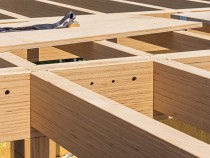
© Eckhardt Matthäus?/?Lattke Architekten
Indigenous hardwood is used mainly for interior fittings in today’s construction industry. Historic structures show that this was not always the case. For example, some types of hardwood, in particular oak, were used in roof trusses and beam and post framed structures because of their durability and high strength. Hardwoods currently play a somewhat marginal role in timber construction. At the moment, engineers working to Eurocode 5 may design with five hardwood types (ash, beech, maple, oak and poplar) and use them as solid wood.
The technical properties and the high aesthetic potential of hardwood are responsible for the material’s increasing use in architecture. Hardwood is a readily available material offering many and diverse options for the future – in the form of slender components or structural elements for highly loaded structures – and will surely continue to surprise us with further innovations. ?(Frank Lattke, Anne Niemann, Klaus Richter)
The technical properties and the high aesthetic potential of hardwood are responsible for the material’s increasing use in architecture. Hardwood is a readily available material offering many and diverse options for the future – in the form of slender components or structural elements for highly loaded structures – and will surely continue to surprise us with further innovations. ?(Frank Lattke, Anne Niemann, Klaus Richter)











